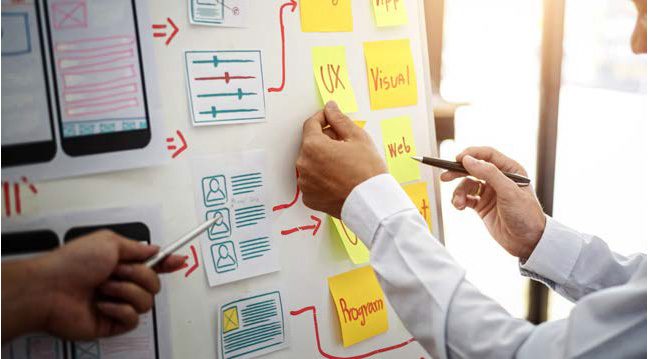
Training
Shift mindset, develop skills,
Looking for a practical, modern course for your team or company?
Customized to your current level of Agile knowledge?
Delivered in an experiential and engaging way?
With solid “how do we” support afterwards?
You’ve come to the right place.
We are not a generic training company or certification provider. Every one of our trainers is an industry thought leader with a balanced record of training, coaching, consulting, and facilitation in Agile. We keep our material current with the ever-expanding Agile frontiers, and all our exercises are original. And after a course is over, you may have 90 days of support for applying the learnings.
The following list contains the “base models” of all the courses we offer to clients. We will conduct preliminary interviews to customize the agenda for your situation.
Every course is available both online and in-person with the same level of quality and outcomes. Online courses are delivered in half-day chunks on consecutive days.
(Note: All of these courses are delivered privately, and generally require at least eight participants. If you have only a couple of people who need training, check out our public courses.)
Virtual and onsite courses

Leading in Agile
2 days
How can you get far better results from your Agile implementation? How can your team have a better working experience? How do you grow as an effective and supportive Agile leader? Discover the answers in this game-changing training.

The Leader’s Guide to the Agile Mindset
1 day
How should you engage with Agile teams as a product development or solution delivery leader – or as their business counterpart? How can you get your objectives met while empowering them? And what should you change for real Agility?

The Executive’s Guide to the Agile Mindset
half day
What does Agile mean to you as an executive? How do you enable real agility in value delivery? With your organization becoming more Agile, what is changing for you and what isn’t?

Being Agile
1 day
If your team has been doing Agile for some time, are they also being Agile? That is, do they truly put people before process, deliver value frequently, respond to change economically and without drama, and collaborate with their customers?

Teamwork and
Collaboration
Kickstarter
half day
Few teams are real teams, despite being called that; they are workgroups. Even when leaders genuinely promote teamwork, little changes. How do you turn this situation around?

Amplifying
Collaboration and Agile
Teamwork
1 day
Your Agile team members communicate and collaborate and decide some things together, but probably not enough. What can you do as a leader to help them fulfill their teamwork and collaboration potential?

Agile for Non-Software
Teams
2 days
To benefit from agility, your non-software department needs a different process than what your tech colleagues use. How do you implement Agile values, beliefs, and principles in a way of working that respects your context and work realities?

Pragmatic Scrum
2 days
How do you go beyond simplistic Scrum mechanics, roles, and artifacts and create real agility? How do you make effective process choices in your context? Whether you’re new to agile or need a refresher, we offer empowerment and options, not certification.

Agile Engineering
2 days
Do your software developers exhibit the necessary Technical Agility to achieve adaptation, better customer-product fit, and frequent value delivery, both short term and long term?

Product Ownership
2 days
Agile product ownership comes with great responsibility, far beyond writing user stories, specifying acceptance criteria, and prioritizing a backlog. How do you create and manage higher-value products with less risk?
It's clear that Gil has mastered the art of coaching/teaching with online tools, and his years of experience working with Agile methods show through. Gil’s sound advice and guidance have armed me with the skills needed to continue my Agile journey.
- Matt S.IT Director (participated in three different courses)
Gil masterfully presented this course online using some of the best tools and practices that enabled all the participants to actively engage in the learning process. The training and the takeaway tools continue to provide amazing value to my leadership growth both at work and my personal life.
- Jeff GortonDirector of Client Experience, Pethealth
I never paid so much attention in a university class as I did in your training. Your delivery was very compelling.
- G. S.Developer
I thoroughly enjoyed Gil's online Agile training. It was engaging and educational, and I've taken many of the practices I learned and applied them in my daily job to maximise both my own and my team's productivity.
- Mat FisherSenior Developer, BGIS
The course was very interactive and included many real life examples. I initially thought it would be difficult to sit through this training online, but the exercises were a good way to engage everyone and allow the introverts to speak/share their thoughts and ideas.
- Christine MohabirSenior Project Manager (on the Business side)
A lot deeper than all the agile training I've had before. Gil has challenged the "by the agile book" mentality and made the training dynamic and interesting. A lot for me to take back and apply to myself and the team.
- Name withheld
I strongly recommend Gil to any group looking to transition from trying to "act" Agile to actually embracing and becoming Agile in mindset. We are so glad we flew in people from all over the world to attend the training — definitely worth it 10x over.
- Albert TsaiSVP, Product, Catapult Sports
Gil did a fantastic job teaching "Pragmatic Scrum". Many participants commented on how much better it was than training which they had received previously, both in substance and in the way Gil delivered it. They came away energized and enthusiastic about applying their learning.
- Eli JuniDirector of Software Engineering, Thoughtwire
I left the workshop with both a much better defined framework of what soft skills are needed to grow my team, and techniques to improve those skills.
- Byron JungSoftware development project manager
Sometimes, reading good advice 147 times on blogs is not as effective as having one person ask you to actually do it. I paid for the course, not an employer; I consider that fee a sound investment.
- Duncan McRaeSoftware developer
Our teams responded enthusiastically to the ideas that Gil presented in "Being Agile." With an Agile mind-set, many immediately began re-examining how they were working, with a new sense of freedom and empowerment.
- Philip WhitcombeDirector, Digital Products, CBC (the Canadian Broadcasting Corporation)
Gil helped my team learn and implement Agile engineering. Later, his assistance was vital in providing me with the confidence, knowledge, and skills for becoming an Agile Team Leader... He is an excellent down-to-earth coach and mentor.
- Matthew CampbellSenior software developer
I found the information Gil provided invaluable and very well presented. The insights gained in that seminar will change my approach to software development forever.
- Alon SabiCTO, Functionpoint Software
Gil is an exceptional agile coach and amazing facilitator. His delivery of seminars was well thought out with great exercises that really captured the essence and complexity of real-life situations and yet were condensed and focused.
- Claudio GambettiEngineering director
Gil delivered an excellent interactive workshop for all our team members. It was an absolute pleasure to learn more about the Agile culture and what that means for us. Seeing the difference between "Being Agile" and "Doing Agile" was incredibly useful.
- Sean McKaigSenior manager, UI development, CBC
Gil brings an enormously helpful message that companies ignore at their peril if they want to deepen their investment in Agile. He’s experienced in many of the challenges to Agile teams, and resourceful in coaching teams through new challenges.
- Michael GoiteinPrincipal project manager at Mobiquity
The course content was excellent and tailored to our needs... Being primarily based on code samples and exercises it was a chance for in-context and practical learning that I have already seen being applied in our code.
- Simon PalmerCTO, Empathica
